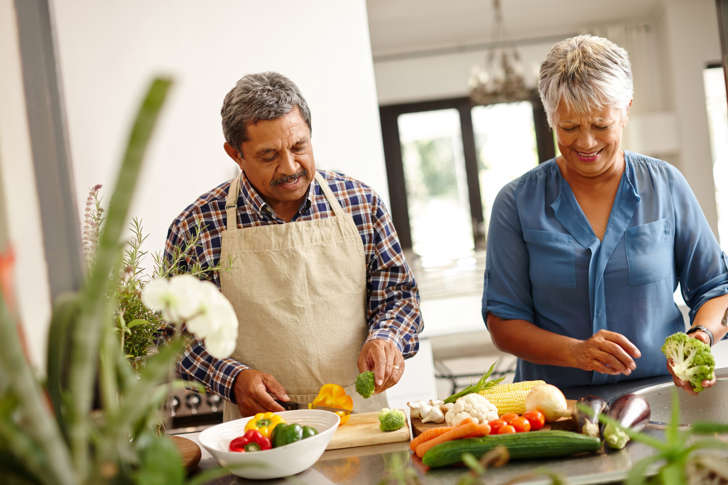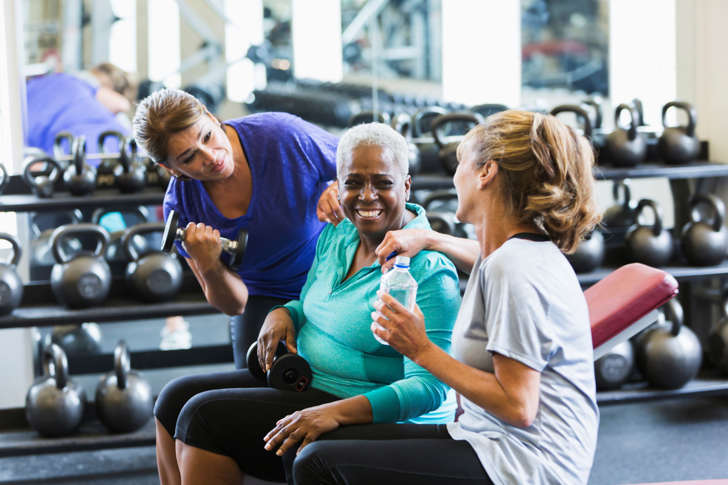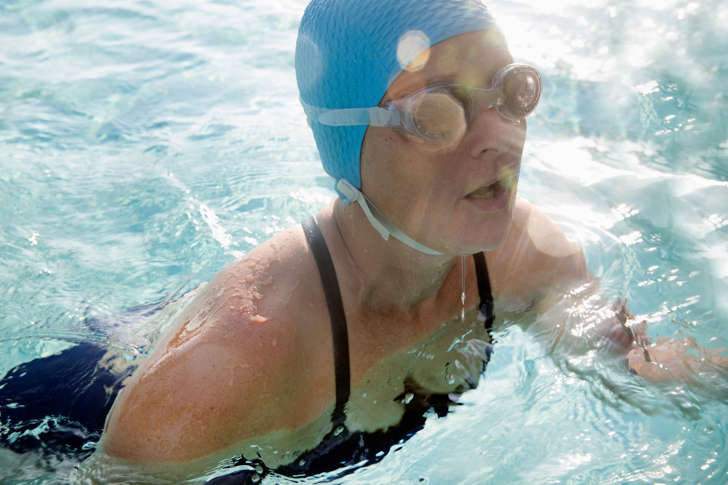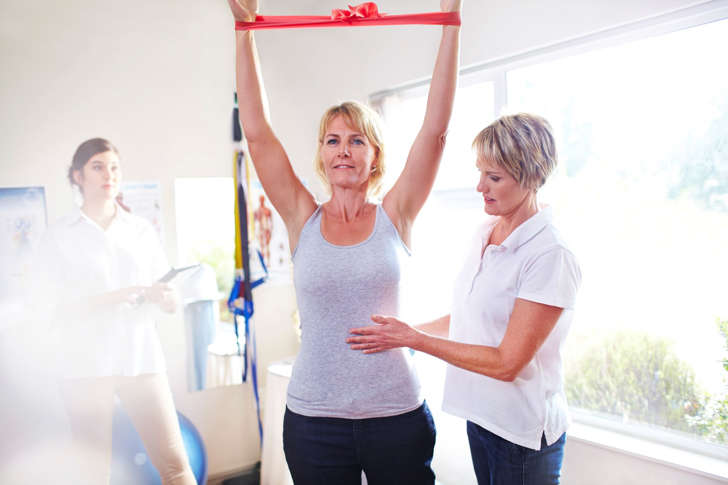7 Ways To Lose Weight After 50
While 50 may be the new 30, there are some physiological truths that can still make you look and feel like 50—especially when it comes to losing weight.
All those years of playing sports, sitting, walking up and down stairs, and moving in general take its toll on joints and muscles; you may notice they’re a little stiffer and sorer than they were a few decades ago. Then, there’s the issue of our ever-slowing metabolisms.
According to the American Council on Exercise, your resting metabolic rate (the ability to burn calories while doing nothing) decreases by about 1 to 2% percent per decade thanks to a decrease in the amount of muscle you carry around (muscle burns calories) and increased fat mass (which is metabolically inactive). To add insult to pudge-boosting injury, our diets often don’t change enough to account for this metabolic slow-down, meaning weight can creep up slowly but surely with every birthday.
“There are a number of roadblocks people in their 50s will face when trying to lose weight,” says Brian Durbin, a NSCA-certified strength and conditioning specialist and personal trainer. “But once you know what they are—and how to work around them—it’s easy to be successful at dropping pounds.”
These 7 little tricks can help you lose weight and keep it off.
1. Embrace weight training.
If you find it tough to make it to the gym at all, let alone brave a weight room filled with buff, 20-somethings, here’s a little motivation: Once you hit 50, you’ve got about 20% less muscle mass than you did when you were 20. And because muscle is so metabolically active, muscle loss equals a slower metabolism. That makes you much more likely to put on (and hold on to) extra pounds, says Durbin. “The good news is you can turn all of this around with a well structured weight training routine,” he says. “That can increase your muscle mass and help you regain the ability to lose weight like you were able to 20 years ago,” he says.
FREE 6 Minutes to Skinny DVD. Get it HERE!
2. Get your hormones checked.
As we age, progesterone, testosterone, and other hormones decline, which sets the body up for storing instead of losing weight, says Jennifer Burns, NMD, a naturopathic physician in Phoenix. “Simply getting your thyroid, adrenal glands, and other hormone levels checked—and then taking the appropriate steps to bring them back into balance—can go a long way toward helping people in their 50s lose weight,” says Burns.
Tami Meraglia, MD, author of The Hormone Secret: Discover Effortless Weight Loss and Renewed Energy in Just 30 Days agrees, adding that she feels the hormone to focus on is testosterone—especially for women over 50 who are trying to get fit. “There is ample discussion in the medical community about the effects of estrogen loss, but few people are aware of the importance of sufficient testosterone levels, which can help a woman slim down,” says Meraglia. In fact, research shows that balanced testosterone levels reduce blood glucose levels, which may help promote weight loss and stubborn belly fat.
3. Choose activities that are easy on the joints.
Janna Lowell, a Los Angeles-based personal trainer says she gets the best results among her 50-somethings when she has them do some cross-training in the pool. Tired joints can keep this population from getting a great workout, she says, and aches and pains can turn some people off exercise completely. “Water exercise is easy on the joints and can boost range of motion as well,” says Lowell. “Even better, caloric expenditure is about 30% greater in the water than on land due to the resistance water creates.” (Check out this 10-minute water workout that blasts calories.) No pool? No problem. Walking is another great, low-impact cardiovascular exercise, as is cycling, kayaking, yoga and dancing.
4. But don’t slack at the gym.
Just because your joints are a little achier than they used to be doesn’t give you an excuse to phone in your workouts. Alex Allred, a former national and professional athlete turned personal trainer says this is one of her biggest pet peeves among 50-year-olds. “Far too many people think that just because they showed up, they’re working out,” says Allred. “But really, you need to be focused on what you’re doing and pushing yourself hard enough to break a sweat or at least complete the full range of motion of a certain exercise.” Not sure if you’re doing a move properly? Ask! “I wish more people would flag down a trainer and ask, ‘Am I doing this correctly?’ ” says Allred. It can make the difference between making the most of your exercise time to lose weight and wasting your time.
5. See a physical therapist.
The advice to consult your doctor before starting any new exercise regimen is great, and Samira Shuruk, an ACE-certified personal trainer suggests taking this advice a step further: Make an appointment with a physical therapist—particularly if an aching back, knee, or other body part has kept you from working out on a regular basis. “After 50, many people have sustained injuries and don’t know what their activity options are,” says Shuruk. “This makes it tough to exercise in ways we used to, and getting advice from a professional can truly help.” Physical therapy can help you rehabilitate an old injury or ease joint and muscle pain, setting you up for pain-free workouts.
6. Overhaul your diet.
Remember that metabolic slow-down? It can mean that you’re burning about 250 fewer calories each day. If you continue to eat like you’re in your 30s—and don’t increase your exercise—you’ll gain weight, plain and simple, says Katie Ferraro, RD, a dietitian and assistant clinical professor of nutrition at the University of California San Francisco School of Nursing. “To lose weight when you get older, you have to eat fewer calories,” says Ferraro. Crowding out the junk food in your diet with loads of fruits, vegetables, and lean proteins can make cutting calories painless.
7. Get your stress in check.
This decade can be prime time for stress, says Durbin. “The average 50-year-old has many more responsibilities than their younger peers. They’re often in their prime income-generating years, which means extra responsibilities at work. They may also have kids who are going to college—a financial burden—or have aging parents who they’re helping to care for.” The result? Emotional eating and a schedule that seems too jam-packed for regular exercise sessions. The solution: schedule your workouts like they’re doctor’s appointments, says Durbin. Sticking to a consistent routine can not only help ease stress but also help people stay on track with their diets. After all, who wants to ruin the benefits of a tough sweat session by eating a donut?
>>>Free 6 week meal plan. Download it today!
6-minute morning routine FLATTENS your belly (eat THIS, do THAT)




